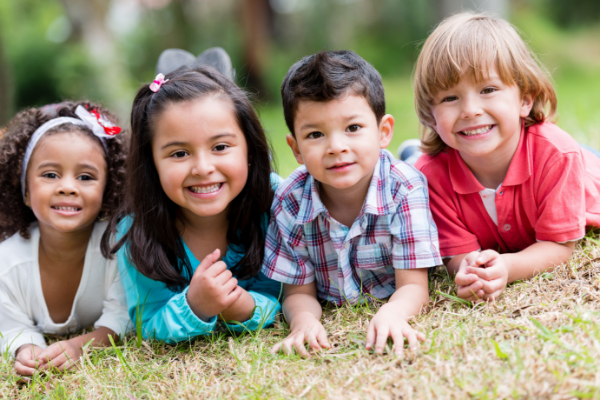With a new school year just around the corner, there’s much learning to look forward to and not all of that will come from textbooks. Aside from the basic mathematics, history, science, and English lessons, children will learn social norms, peer connection, and even a little healthy competition. From teachers at school, parents at home, and peers all around, children will continue to determine what’s acceptable and what’s not. So how can we, as parents and authority figures, make sure that compassion, justice, and support for one another become the norm for our children, rather than indifference, intolerance, and hate? In this current political climate especially, the need for our youngest generation to become upstanding allies is all the more important.
So what can we do to send our children into the school year equipped and ready? Tahirih breaks down a few ideas:
Educate ourselves
Educating our children begins with educating ourselves, confronting our own biases and correcting our own harmful behaviors. It’s a process that never truly ends, and it starts with understanding our own identities (and with that, our privileges) through the lens of history.
Most of us, for example, are not indigenous to this land. And even if we are not direct descendants of the European settlers who colonized this land, most of us still benefit from America’s long, violent history of settler-colonialism by living on stolen land. (If you’re interested in learning more about tribal sovereignty, we highly recommend listening to the podcast This Land.) Today, the U.S. government uses ICE raids and detention centers to guard this land from migrants seeking to escape violence and poverty in their homes — even though many Latinx immigrants have ancestors who have been in the Americas for much longer than the U.S. has existed.
There are other privileges and systems of oppression to consider, as well: racism, sexism, homophobia, transphobia, ableism, xenophobia, and classism, just to name a few. These systems all intersect, and none can be understood without the context of history — and not just American history alone. A conversation about classism, for example, would be incomplete without discussing the wealth of the Western world in comparison to the Global South — a wealth gap that exists as a result of centuries of colonialism, imperialism, and other forms of exploitation. (And that discussion helps inform us about immigration, the climate crisis, and so much more.)
There is, of course, too much information in and about the world for any of us to ever comprehend the full histories of our identities. But when we think about social justice and systems of oppression, it is not enough to understand how they affect people right now. We have to ask why, and then when we get an answer we must ask why again.
We have to ask why, and then when we get an answer we must ask why again.
Why, for example, do so many people from the Global South immigrate to the U.S.? Many immigrants are fleeing violence, persecution, or extreme poverty, but why are those such pervasive problems in their home countries to begin with? Believing that the people of the Global South are simply “less developed” could provide an easy, but wrong, answer — we need to look to the Western world’s history of imperialism and colonialism to answer this question.
Asking “why” is a question that demands empathy and forces us to understand the situation of another, hopefully evoking compassion. The thought of thoroughly educating ourselves, much less our children, about each aspect of our identities might (understandably) feel daunting and overwhelming, but, ultimately, empathy and compassion are the foundations of social justice. Perhaps one of the best ways to teach our children to be upstanding allies is to teach them to understand and care for each member of our human family, and as they grow up and learn more about the world and its history, they can be guided by these values.
Cultivate empathy and emotional intelligence
Humans have an inspirational capacity for love and compassion, but developing emotional intelligence requires effort. Processing emotions in a healthy way, engaging in healthy relationships, or resolving conflicts peacefully are skills that can be taught, learned, and improved with practice.
One way to start is by talking to your child about their feelings. Not only is talking a healthy way to process emotions, but research indicates that the way we articulate our emotions can shape how we experience and understand them. Talking about emotions with young boys is especially important, as parents often subconsciously restrict the range of emotions their boys experience by using less emotional language with them. Later in life, this can result in emotional suppression possibly explaining why men more often resort to physical violence than women.
In these conversations, it’s important to be a good listener, both so that your child feels comfortable sharing their emotions and to model good listening. Parent-child communication experts Adele Faber and Elaine Mazlish wrote a book about this, called How to Talk So Kids Will Listen & Listen So Kids Will Talk, and YouTuber and mental health advocate Anna Akana made an informative video summarizing some of the book’s main points about listening.
There are other emotional skills you can model as well. If you have a partner, for example, think about how you resolve conflicts with them. Children, especially young ones, are like sponges. They’re learning how to resolve conflicts and how to act in relationships based on their observations of the people and relationships around them.
You can also model empathy and kindness in the way you talk about others or treat strangers. How do you and your family members talk about people of different races or gender identities? How do you treat people with disabilities, service workers, and homeless people?
How do you and your family members talk about people who are different from you?
Another important aspect of emotional intelligence is understanding consent — not just sexual consent, but consent when it comes to physical and emotional boundaries as well. Model consent by asking your child and those around you before crossing boundaries (e.g. asking “Do you want a hug?” or “Is it okay if I talk to you about ____” if it’s a heavy or emotional topic). And, of course, pay attention to their answer. Listening when your child says “no” will teach them that they should expect to have their boundaries respected (which may be especially important for girls and women, whose emotional and physical boundaries are frequently disregarded).
Teach about social justice and allyship
Educating ourselves and cultivating our children’s emotional skills are both important and necessary parts of raising good, upstanding allies, but there are ways we can also explicitly teach our children about social justice. We can start by talking to our children frankly and openly about systems of oppression. Children are smarter than we give them credit for, even if they don’t know as many big words as we do. And regardless of whether we choose to talk to them about it, children’s lives are already shaped by systems of oppression.
We can start by talking to our children frankly and openly about systems of oppression.
Part of this open conversation about social justice and systems of oppression can include pointing out harmful behavior when you see it and explaining why it’s wrong. Maybe students at school are bullying a peer for being gender nonconforming, upper-class white parents are overheard saying low-income students of color will worsen the quality of their child’s education, or a movie objectifies its only female character. These events aren’t just opportunities to start a conversation about transphobia, racism, or sexism; it’s crucial to let your child know that these behaviors are harmful and unacceptable and explain why.
Just as important, though, is pointing out positive examples of allyship, inclusion, and compassion, and explaining why those are model behaviors. Highlighting positive behavior shows your child that there are alternatives to harmful, intolerant behavior, and explaining why certain actions are good can help them figure out how they want to behave in their own world.
But, your voice, though important, is only one voice, and can only provide your child with your own perspective of the world. Another way to teach your child about inclusivity and tolerance is to expose them to different points of view through the media that they consume. Think about the TV shows and movies they watch. Are the creators mostly white men? What about the authors of the books they read or the artists behind the songs they listen to? Storytelling has an amazing capacity to help us empathize with those who are different than us and it’s important that our children learn the stories of many different people with a diversity of backgrounds and identities.
Learn how to mess up
In the wise words of early-aughts Disney pop sensation Hannah Montana (nee Miley Cyrus), “Nobody’s perfect.” Learning how to be a better ally and unlearning our harmful behaviors and biases is an ongoing, non-linear process. So when we inevitably mess up, whether by making an off-handed comment about race or gender, or by taking out our stress and fatigue on our kids, it’s important to recognize how our words or actions harmed someone, accept responsibility and apologize, and then allow ourselves and others to move on so that we can do better in the future.
We hope that these tips help you feel prepared for the new school year! To gear up even more, check out our new Tahirih Marketplace Back-to-School line, featuring youth t-shirts, hoodies, and onesies!


